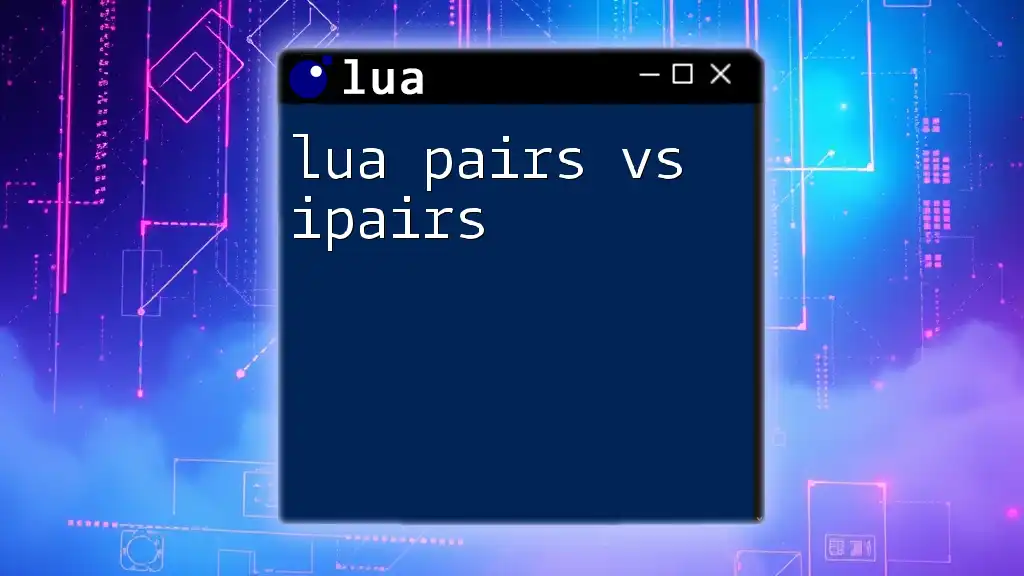In Lua, `pairs` is used to iterate over all elements in a table regardless of their index type, while `ipairs` is specifically designed to iterate over array-like tables with integer keys, stopping at the first nil value encountered.
Here's a code snippet demonstrating the difference:
local exampleTable = {
"apple",
"banana",
[5] = "cherry",
"date"
}
print("Using pairs:")
for key, value in pairs(exampleTable) do
print(key, value)
end
print("\nUsing ipairs:")
for index, value in ipairs(exampleTable) do
print(index, value)
end
Understanding Tables in Lua
What is a Table?
In Lua, a table is the primary data structure that acts as both an array and a dictionary. Tables are highly flexible, allowing you to create complex data models by storing different types of data including other tables, strings, numbers, or functions.
The versatility of tables means they can be used to implement various data structures, such as lists, sets, and records. This makes understanding tables essential when working with Lua, as almost everything revolves around them.
Types of Tables
Tables in Lua can generally be categorized into two types:
- Array-like tables: These are indexed numerically, using consecutive integers as keys. They are similar to arrays in other programming languages.
- Dictionary-like tables: These are indexed using keys that can be of any type (except `nil`), allowing for associative arrays that store key-value pairs.

Overview of Iteration in Lua
Why Iteration is Important
Iteration plays a crucial role in programming, as it enables the manipulation of data within a collection like tables. Whether you're gathering user input, processing data, or generating output dynamically, knowing how to iterate efficiently saves time and prevents errors.
Common Iteration Functions in Lua
Lua provides several methods to iterate through tables, with the for loop and while loop being among the most popular. However, for working specifically with tables, the pairs() and ipairs() functions are tailored for this purpose. Understanding how to use these will significantly enhance your data handling capabilities in Lua.

Pairs Function
What is the `pairs()` Function?
The pairs() function in Lua is designed to iterate over all elements of a table, regardless of the type of keys used. This function is particularly useful for traversing dictionary-like tables where keys may be strings or numbers, and the order is not inherently important.
Syntax of `pairs()`
The syntax for the pairs() function is straightforward and is structured as follows:
for key, value in pairs(table) do
-- code to execute
end
When to Use `pairs()`
You should use pairs() when you need to iterate through all entries in a table, especially if:
- You are working with dictionary-like tables where the key-value pairs are not sequential.
- The keys are not purely numerical and can be strings or other types.
Example of Using `pairs()`
Here's a simple example that demonstrates the use of pairs():
local myTable = {name = "John", age = 30, city = "New York"}
for key, value in pairs(myTable) do
print(key .. ": " .. value)
end
In this example, the output will display each key and its corresponding value, allowing you to visualize the table's structure.

Ipairs Function
What is the `ipairs()` Function?
The ipairs() function is another iteration method tailored specifically for array-like tables that are indexed numerically. Unlike pairs(), ipairs() respects the order of indices, iterating through the table from the first index to the last.
Syntax of `ipairs()`
The syntax for using ipairs() is similar to pairs():
for index, value in ipairs(array) do
-- code to execute
end
When to Use `ipairs()`
You should opt for ipairs() when iterating through array-like tables where:
- The order of elements is crucial, and you need to process them sequentially.
- You expect the indices to be contiguous and numeric.
Example of Using `ipairs()`
Here’s a simple demonstration of ipairs():
local myArray = {"Lua", "is", "fun"}
for index, value in ipairs(myArray) do
print(index .. ": " .. value)
end
The output will display the index and value of each entry, emphasizing the sequential nature of the iteration.

Key Differences Between Pairs and Ipairs
Comparison of Functionalities
The core difference between pairs() and ipairs() lies in their iteration behavior.
- pairs() iterates over all elements in a table, regardless of the key type or order, making it suitable for associative arrays.
- ipairs(), on the other hand, iterates only through numerical indices from 1 up to the first nil value it encounters, which is ideal for array-like structures.
Use Cases
When choosing between pairs() and ipairs(), consider the nature of your table:
- Use pairs() for dictionary-like tables or mixed-type keys.
- Use ipairs() for array-like tables where you need sequential access.
Example Scenarios
To illustrate the differences, consider this code with a mixed table:
local mixedTable = {1, 2, nil, 4, name = "Lua"}
print("Using pairs:")
for k, v in pairs(mixedTable) do
print(k, v)
end
print("Using ipairs:")
for i, v in ipairs(mixedTable) do
print(i, v)
end
Here, the output for pairs() will include all key-value pairs, whereas ipairs() will stop at the first `nil`, yielding non-sequential results.

Common Mistakes and Tips
Avoiding Common Pitfalls
One common mistake when using pairs() or ipairs() is misunderstanding the implications of nil values. When using ipairs(), if there are any gaps in the numeric index sequence, the iteration will terminate unexpectedly.
Best Practices
To ensure efficient and effective table iteration in Lua, follow these best practices:
- Always choose the appropriate iteration function based on the structure of your table.
- Consolidate your data into a format suitable for the type of iteration you plan to use.
- Test your code with varied datasets to validate the behavior of your iteration logic.

Conclusion
In conclusion, understanding the differences between lua pairs vs ipairs is essential for effective table manipulation in Lua programming. Both functions serve distinct purposes, and the choice between them can significantly influence the performance and outcome of your code. By mastering their usage, you will enhance your Lua programming skills and become more adept at handling complex data structures.

















